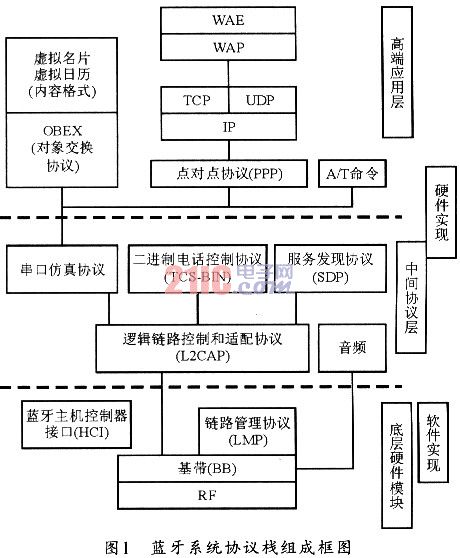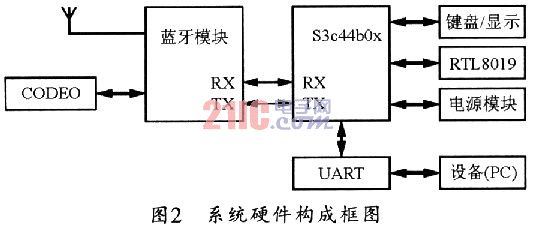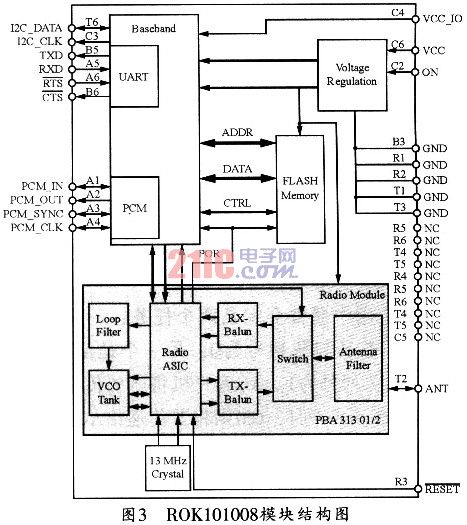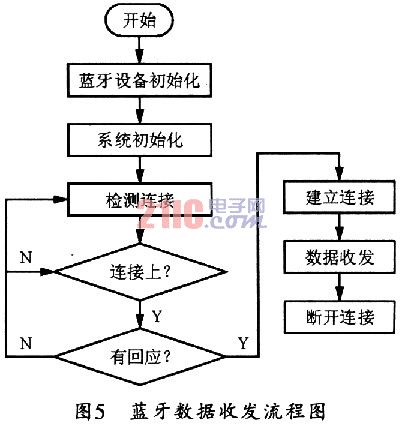Abstract: The terminal microprocessor developed by the ARM7TDMI S3C44BOX device with 32-bit kernel as the Bluetooth audio gateway is given. The design method of the Bluetooth audio gateway system is formed by the UART and S3C4480X connected by the Bluetooth module ROKl0l008. The system is connected to a Bluetooth Headset for pairing and voice data transmission.
Keywords: S3C4480X; Bluetooth; audio gateway
This article refers to the address: http://
O Introduction For the last ten meters of transmission problems, Bluetooth technology has gradually become the preferred technology for low-cost, short-range wireless personal network transmission. Its main goal is to provide a full-duplex wireless transmission environment for wireless transmission of voice and data. . For short-distance transmission, Bluetooth can use high-speed frequency hopping technology (FH) to ensure the stability of the link, and the anti-interference is strong, not easy to eavesdrop. In addition, the price of the Bluetooth chip is low and the expansion is easy. The home audio device network can also be controlled via Bluetooth.
To this end, this paper designs a Bluetooth audio gateway (AG) system based on S3C4480X, which can realize point-to-point connection with Bluetooth headset to establish an audio connection, thus achieving pairing and voice data transmission between the two. .
l Bluetooth architecture The Bluetooth wireless communication protocol standard includes two major parts: the core protocol and the application framework. The purpose of the Bluetooth protocol standard is to be able to operate with each other in compliance with the specification application. In order to achieve mutual operation, the corresponding application on the remote device must run on the same protocol stack. The architecture of the Bluetooth protocol can be divided into a physical layer, a data link layer, an intermediate protocol layer, and an application layer. FIG. 1 is a block diagram of a system component of a Bluetooth system protocol stack. The core protocol of Bluetooth includes four parts, namely baseband, link management, logical link control and adaptation protocol (L2CAP), and service search protocol (SDP). Among them, L2CAP is responsible for establishing logical link connections, providing tasks such as protocol multiplexing, segmentation and reassembly of data packets between the upper layer and the bottom layer. SDP provides service search and service browsing functions, and is responsible for querying and accessing services between Bluetooth devices.

The Bluetooth Host Control Interface (HCl) provides a command interface for the baseband controller, connection controller, hardware status, control registers, and provides a common interface between the host and baseband of the Bluetooth device. The protocol above the HCI layer runs on the host, and the following protocols are done by the Bluetooth host controller hardware. This not only ensures the stability of the underlying protocol transmission, but also supports the scalability of the upper layer application protocol.
2 system hardware structure and design This paper selects Samsung's 32-bit core ARM7TDMIS3C44BOX as the processor, and builds the system hardware platform through Bluetooth module, audio codec/CODEC (CODEC), Ethernet interface. The system is based on the Bluetooth BlueStack protocol stack, which can realize all the functions of Bluetooth. The Bluetooth audio gateway system is based on BlueStack. The S3C44BOX and RTL8019 are used to develop a 10Mbps Ethernet interface that allows the system to communicate with Ethernet and operate over Ethernet. Figure 2 is a block diagram of its system.

2.1 Structural Features of Bluetooth Module ROKl01008 This system uses the ROKl0l008 module of Ericsson. The Bluetooth module has high integration, low power consumption, and can provide functions up to the HCI layer of the control interface. It has three hosts: UART, I2C and PCMCIA. Control interface for easy Bluetooth voice and data transmission with the host. ROKl0l008 supports Bluetooth specification v1. OB, its receiver's maximum input level is +13 dBm, wide dynamic range, to ensure reliable communication of the transmitter, its output power can reach Class2, UART maximum data stream is 460 kbps. At the same time, ROKl01008 supports voice and data transmission functions, enabling point-to-point connections.

The composition of the ROKl01008 module is shown in Figure 3. The module has five modules: wireless transceiver, baseband controller, flash memory, power management and clock. The wireless transceiver module is composed of a Bluetooth transceiver and an antenna. Its function is to provide wireless channels for gateways and terminal devices. The baseband controller can complete the synthesis of the frequency, complete the conversion and filtering of the data bit signal of the baseband module to the radio signal, and transmit the radio signal with a certain power and frequency hopping frequency. ROKOl008 operates between 2.4 GHz and 2.5 GHz ISM with 79 channels, each with 1 MHz.
2.2 Bluetooth Audio Gateway Hardware Architecture The Bluetooth audio gateway hardware includes a Bluetooth chip and an audio codec (CODEC). The embedded Bluetooth audio gateway circuit is mainly used to provide an audio input/output interface and establish an audio connection. Figure 4 shows the hardware circuit of the Bluetooth audio gateway. The Bluetooth module voltage is +3.3 V. The UART of the Bluetooth module is connected to the UART of the S3C44BOX of the single chip microcomputer. It can constitute a communication channel. The S3C44BOX can also communicate and interoperate with the PC via the UART interface. The CODEC is responsible for the audio input and output.

3 Bluetooth audio gateway software design Bluetooth audio gateway implementation is mainly based on the Bluestack protocol stack, audio gateway software is divided into three layers, namely BlueStack protocol stack, AG client program and connection manager.
BlueStack is the Bluetooth protocol software stack of Cambridge Consulting Co., Ltd., which can be implemented in C language. It follows the layered model proposed by the Bluetooth Special Interest Group and supports the use of serial port emulation protocols or binary telephony control protocols for logical link control and adaptation protocols as a specification layer for transport protocols. All Bluetooth functions are implemented based on the BlueStack protocol stack.
The entire BlueStack protocol stack implementation is message driven, and the message queue is used between layers. In the embedded Bluetooth audio gateway application, there are generally two types of messages involved: CM messages and BlueStack messages. CM messages can be passed between the client and the connection manager, while BlueStack messages are passed between the BlueStack stacks. The BlueStack primitive types are DM PRIM, RFC_PRIM, SDP_PRIM and L2CAP_PRIM. In AG applications, the first three are generally used. The BlueStack message format is DM (RFC, SDC or SDS)_primary_extension.
In an AG application, two tasks are usually defined. One is a CM task, the task number and queue number are O, and the other is an AG task. The task number and queue number are 1. The AG client submits the message to be delivered to the CM to the queue 1, and the CM submits the message to be delivered to the AG to queue 0.
The application should provide a communication interface between ARM and Bluetooth, mainly to establish two L2CAP channels (control channel and data channel) between the hosts. At initialization, the Bluetooth module should be woken up and write data operations (queue form), then establish a connection by request. When the AG client sends a request signal, if the CM responds, it indicates that a connection can be established. During data transmission and reception, data is encapsulated/unblocked, classified, and so on. Figure 5 shows the software flow chart of the Bluetooth data transceiving process.

4 Conclusion The S3C44BOX core is powerful and can be embedded in the operating system, so the embedded operating system platform can be built by the single-chip system. Based on the ARM platform, this paper designs a Bluetooth audio gateway based on S3C44BOX. After testing, the gateway can realize the access of the Bluetooth headset and successfully realize the pairing and voice data transmission. Before the Bluetooth headset and the audio gateway interact with each other, a paired connection needs to be established, that is, the connection is implemented through Bluetooth authentication and binding. Once this relationship is established, you don't have to do this again.
USB Cable advantage:
This product is made of cowboy cloth, smooth handle, beautiful color and various colors.wire has strong bearing, easy to break, and excellent anti winding effect.The charging interface and USB interface are made of high quality nickel plated joint. It is not easy to rust and plug. After repeated plugging and using, it will still not affect contact. 2.4 A high-speed charging, transmission two in one: perfect performance to achieve lossless fast charging and real-time data synchronization function.High purity oxygen free copper wire core: high purity oxygen free copper core is adopted inside the wire to ensure excellent conductivity.

Double Side Usb Cable,Double Side Micro Usb Cable,Double Side Micro Cable,Micro Usb Data Cable
Dongguan City Leya Electronic Technology Co. Ltd , http://www.dgleya.com